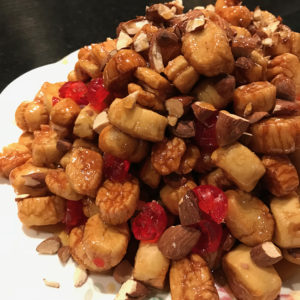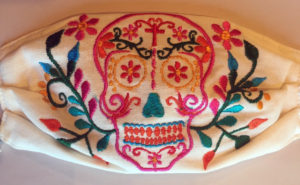September comes to a close this week and as it does, we get to celebrate with subtle sweetness. We begin with the setting sun this 25th of September and the start of Rosh Hashanah, the Jewish New Year. Apples and honey are traditional to Rosh Hashanah: eat these sweet things to help ensure a sweet year ahead. You might also eat challah bread and Teiglach: small balls of dough that are baked in honey and mixed with chopped roasted almonds and candied cherries. My family discovered them one September in a local Jewish bakery. We were mesmerized by the tin plates of Teiglach, piled high into a cone, wrapped in cellophane. They reminded us so much of the struffoli we make each Christmas. We bought a plateful and took it home and the teiglach was so good, we went back the next day for another. Something about the nuts and the cherries and the honey make for a sublime combination of sweetness and substance and texture. Eventually, we began making our own, and my sister’s Teiglach are what you see in the photo above. They are so good! L’shanah Tovah is the greeting we say: Have a good, sweet year.
The next day, on the 26th of September, we celebrate the birthday of John Chapman, better known as Johnny Appleseed: our great American apple-planting frontier traveler. He was born at the height of apple season in 1774. Read his story, watch the short animated Disney Melody Time film about him. At the very least, eat an apple. Better yet: drink a tankard of hard cider. John Chapman was not so much interested in planting apples for eating as he was in planting apples for cider making. Back then, cider, thanks to its alcohol content, was a lot safer to drink than water!
We close the month on the 29th with Michaelmas, honoring Michael the Archangel. Blackberries are traditional to Michaelmas, thanks to the story of Michael battling Satan, the fallen angel. As the story goes, when Satan fell to Earth, he landed in a bramble patch––a blackberry patch. I love blackberries, but I can tell you––from well remembered experience harvesting blackberries in Maine––that they are a fruit that will make you curse and swear as you gather them. So many thorns. They lay claim to your clothes and wound you. Satan cursed the bramble patch he landed upon, and legend has it that he returns each year to curse and spit upon that same patch. Some folks will not eat blackberries after Michaelmas for this very reason.
Roast goose for dinner is traditional for Michaelmas, and it is one of the first traditional nut-roasting nights of autumn. In Scotland, there are Struan Micheil, Michaelmas bannocks, somewhat like a scone but a flatbread, basically, cut into wedges, typically made from equal amounts of oats, barley, and rye, traditionally made without the use of metal: wooden fork, wooden or ceramic bowl, baking stone. And served, of course, with blackberries or blackberry jam.
The day belongs to St. Michael the Archangel, but traditions have arisen in various parts of the world that honor other angels this day, too. Some will honor Gabriel and Raphael along with Michael. Others will include Uriel, Raguel, Ramiel, and Sariel. This is something I’ve written about in the past about Michaelmas, but will say it again, for I love speaking this litany of angelic names each autumn, and the further down the roster we go, the more mysterious the names become as we cross a fascinating linguistic bridge to ancient tongues. The “-el” suffix of these angelic names is Sumerian in origin, signifying “brightness” or “shining,” names that in their true form would be Micha-el, Gabri-el, Rapha-el, Uri-el, Ragu-el, Rami-el, Sari-el. The list continues: Camael, Jophiel, and Zadkiel; Anael, Simiel, and Oriphiel; Metatron, Israfil, and Malak al-Maut. Their etymology connects to the Akkadian ilu (radiant one), the Babylonian ell (shining one), the Old Welsch ellu (shining being), Old Irish aillil (shining), Anglo-Saxon aelf (radiant being), and English elf (shining being). Speak these names aloud; immediately we are transported to an ancient time, a time when angels were perhaps more commonly seen, in all their radiance.
Are they still around? Many folks think so, and I am not one to doubt them. In a few days time, on the 2nd of October, we’ll celebrate another angelic day, one even older than Michaelmas and one much more personal: the Feast of the Guardian Angels. Its roots are in the Fourth Century, when believers began setting up altars in their homes each October in honor of their angelic protectors. How auspicious that we get to walk amongst angels this time each year.
COME SEE US!
We begin popping up a lot throughout South Florida these last few months of the year. Here’s where you’ll find us in October:
OKTOBERFEST
Friday, Saturday, & Sunday October 7, 8, & 9, and again Friday, Saturday, & Sunday October 14, 15, & 16. Tickets are required and must be purchased ahead of time (and they usually sell out). Click here for tickets.
American German Club
5111 Lantana Road, Lake Worth, FL 33463
We’ll be there both weekends with our big 10′ x 20′ tent filled with German Advent Calendars and handmade artisan goods from Germany for seasons throughout the year, and right next door to us you’ll find my mom and sister in their own tent selling Mom’s embroidery work: Millie’s Tea Towels.
November dates include Dia de Los Muertos in Lake Worth and Florida Day of the Dead in Fort Lauderdale (both on Saturday November 5, sorry!), the Swedish Julmarknad (Christmas Market) in Boca Raton on November 19, Krampusnacht on December 9 at the American German Club in Lake Worth, and Krampusnacht leads us into the American German Club’s Christkindlmarkt on December 10 and 11. I’ll keep you posted of each right here at the blog, or check the events listing at our Facebook page: @conviviobookworks.

